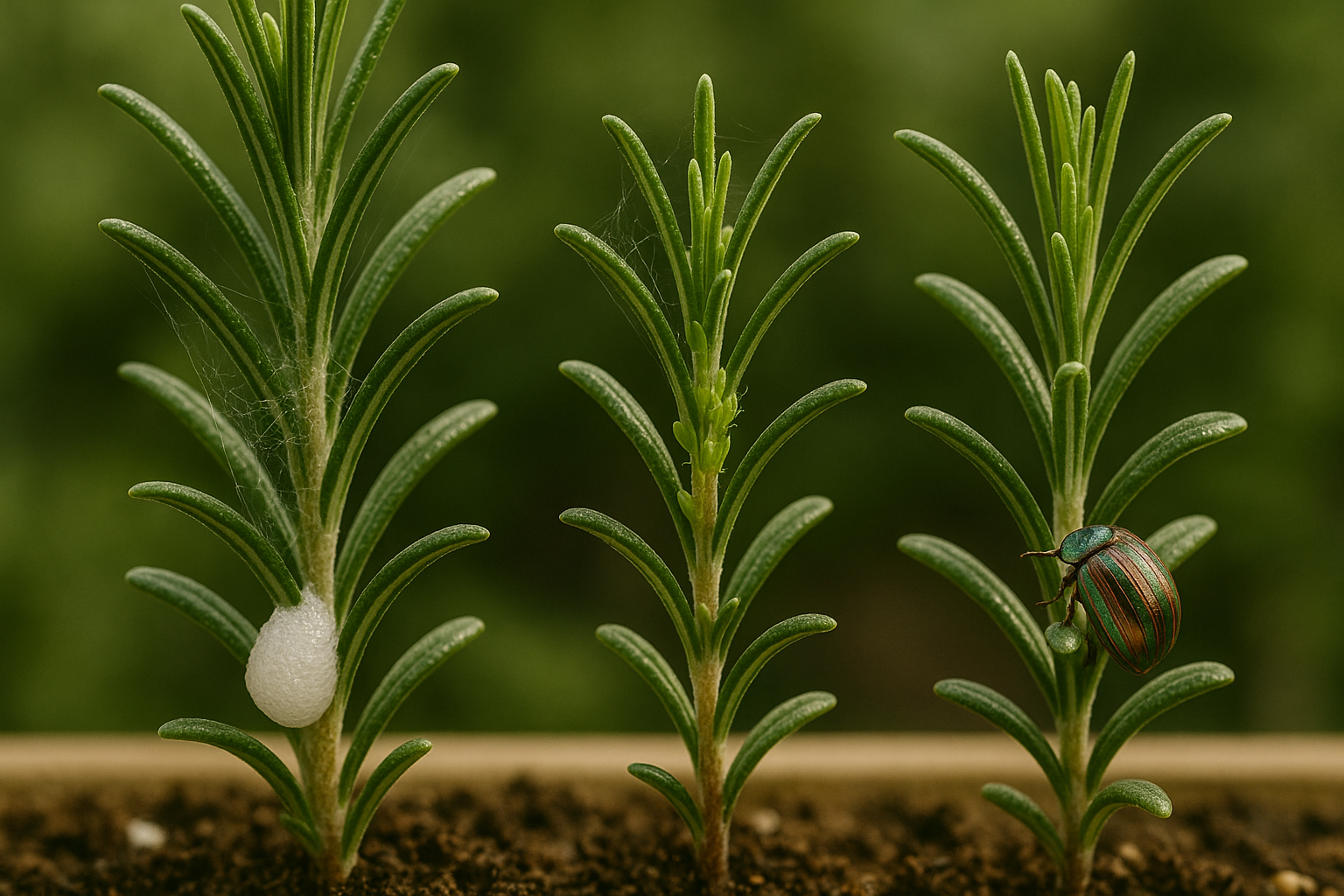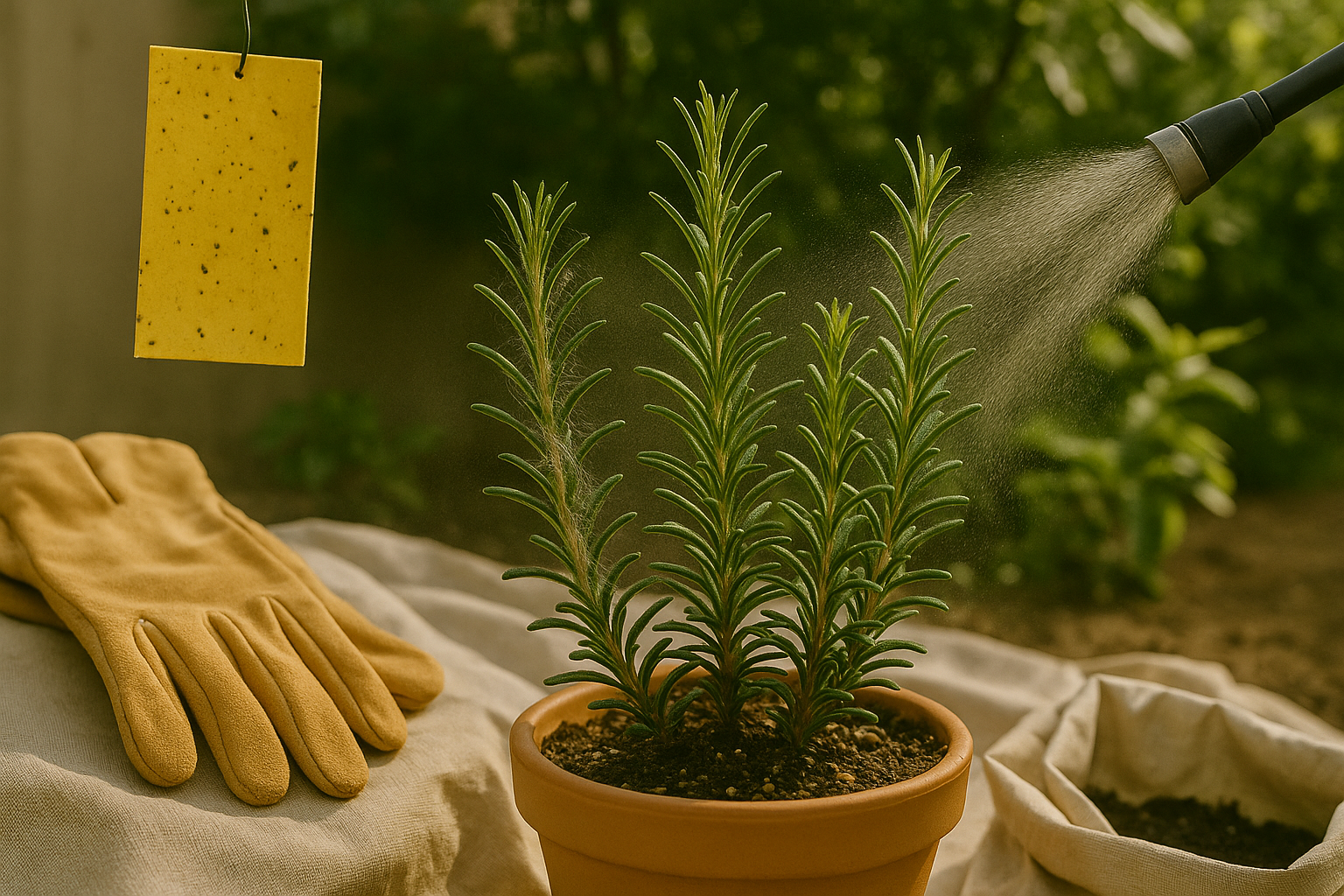Introduction
Rosemary pests can quickly turn the joy of tending a fragrant herb garden into a frustrating battle. Rosemary is cherished by home gardeners for its savory flavor in the kitchen and its decorative, drought-tolerant appeal in gardens and pots. But pest issues matter—if left unchecked, these uninvited guests can stunt growth, discolor leaves, and even kill your plants.
Common culprits include aphids, spider mites, whiteflies, and mealybugs, each capable of thriving on rosemary’s aromatic stems and foliage. If you notice yellowing leaves, sticky residues, or tiny webs, you might already be hosting a rosemary pest problem without realizing it.
In this article, you’ll learn how to confidently identify which pests are bothering your rosemary, understand the damage they cause, and discover straightforward, effective ways to get rid of them for good—so your rosemary thrives, and you can keep savoring its benefits in your home and meals.
Identifying the Most Common Rosemary Pests

Rosemary plants can attract a variety of pests, each leaving telltale signs that help you quickly spot trouble and take action. The rosemary beetle is a frequent culprit, easily recognized by its shiny metallic body and the ragged, eaten leaves it often leaves behind. Spittlebugs, also known as froghoppers, create distinctive blobs of frothy white foam on stems and leaves.
Leafhoppers may cause stippling or pale spots on foliage, while tortrix moth larvae roll and web leaves together, leading to distorted growth. Spider mites, though tiny, create fine webbing and can make leaves appear speckled or bronzed. Mealybugs look like small cottony masses clustered on stems, excreting sticky honeydew that encourages mold.
Scale insects resemble tiny brown or white shells, clinging to stems and the undersides of leaves, often causing yellowing or leaf drop. Fungus gnats are less about leaf damage and more about tiny black flies hovering near the soil, often accompanied by root-related decline.
Aphids cluster on new growth, leaving sticky residue and curled leaves behind, while whiteflies flutter up in clouds when plants are disturbed, causing yellowing and stunted growth. Accurately identifying these pests is key—without a correct diagnosis, you risk using the wrong treatment and allowing your rosemary to suffer longer.
Manual and Natural Pest Control Methods

When it comes to protecting your garden from pests, manual and natural pest control methods offer effective, chemical-free solutions that are safe for both your plants and your health. One of the simplest approaches is hand-picking insects—just grab a pair of gloves and remove beetles, caterpillars, or eggs right off your plants. This works best for larger pests visible to the eye, like tomato hornworms or Japanese beetles.
For smaller pests, simply shaking infested branches over a sheet or bucket can make them fall off, allowing you to dispose of them easily. Regular pruning of affected leaves and stems also helps stop infestations from spreading. If you’re dealing with stubborn aphids or mites, try blasting them off with a strong jet of water from your hose—most can’t cling to wet leaves after such a rinse.
Setting up yellow sticky traps is another smart move; flying insects like whiteflies are drawn to the color and become trapped before they can breed. For indoor plants, vacuuming is surprisingly effective against small soft-bodied bugs, though be sure to empty the vacuum outdoors.
Beyond direct removal, encourage natural predators by planting pollinator-friendly flowers or putting up birdhouses to attract birds, ladybugs, or lacewings—these garden allies feast on common pests and help restore balance naturally. Avoid reaching for chemical sprays, especially on fruits and vegetables, since residue can remain and potentially harm your health or beneficial insects.
By using these eco-friendly strategies, you’ll keep your garden thriving with minimal risk to your food or the local ecosystem.
Biological & Organic Controls
When caring for rosemary, keeping it healthy and pest-free doesn’t mean you have to reach for harsh chemicals. For a safe, effective approach, try non-toxic sprays like soapy water or neem oil to tackle aphids and spider mites. Simply mix a few drops of mild dish soap or neem oil in water, spray directly onto affected leaves, and rinse after a few hours if desired.
To fight powdery mildew, a common problem for rosemary, you can use a diluted milk solution (1 part milk to 9 parts water) or spray a mixture of baking soda (1 teaspoon per quart of water) onto the leaves. Apply every few days until symptoms fade.
Always spray early in the morning or late evening, when pollinators like bees are less active, and avoid spraying blooming flowers directly to keep beneficial insects safe.
Prevent fungal issues in the first place by:
- Spacing rosemary plants for better airflow
- Pruning regularly
- Watering at the base—not over the leaves—ideally in the morning so plants dry quickly
These simple steps, repeated as needed, will keep your rosemary thriving, chemical-free, and safe for everyone in your garden—including helpful pollinators.
Dealing with Specific Pests
Dealing with specific pests in your garden or indoor plant collection starts with knowing what to look for and acting quickly. The rosemary beetle, for instance, is easy to spot with its metallic green-and-purple stripes and is notorious for chewing holes in rosemary, lavender, and sage leaves. A simple, effective control method is to hand-pick beetles and larvae off the plants, especially in the evening when they’re most active—drop them into soapy water to ensure they don’t return.
Spittlebugs, also called froghoppers, are best identified by the frothy “spittle” they leave on stems and leaves, which shields their nymphs. This foam can be wiped away with a damp cloth or dislodged with a spray of water. While unsightly, spittlebugs rarely cause serious harm, though high infestations can stress young plants.
For leafhoppers and tortrix moths, check for curling, yellowing, or chewed leaves. Leafhoppers may look like small green or brown triangles that jump when disturbed, while tortrix moth caterpillars fold leaves and stick them with silk. Prune away damaged areas and remove any larvae you find; timely pruning helps plants focus energy on healthy growth.
Spider mites appear as tiny red or yellowish dots, often accompanied by fine webbing, and mealybugs look like sticky cotton clumps on stems. Both sap plant juices and thrive in dry, crowded conditions. Scale insects are brown or translucent shells stuck to stems, while aphids cluster on new growth.
For all these pests, isolate affected plants, wash leaves with mild soapy water, and wipe or dislodge insects. Regular misting can deter mites, and improving airflow helps prevent outbreaks. Outdoors, pests are often kept in check by predators, but indoor plants are more vulnerable due to lack of airflow and natural controls. A common mistake indoors is overwatering or crowding, which creates perfect conditions for pests.
Staying observant, reacting quickly, and avoiding excessive fertilizer will help keep pests at bay both indoors and out.
Integrated Pest Management for Long-Term Rosemary Health
Integrated Pest Management (IPM) focuses on keeping rosemary plants healthy through a mix of preventive and targeted strategies that minimize chemical use while maximizing plant vigor. Start by regularly inspecting your rosemary for early signs of pests, like aphids or spider mites, and remove any affected leaves by hand.
Keep the area around your rosemary clean—clear away dead foliage and debris, which can harbor pests or disease. Promote natural pest resistance by maintaining good air circulation; prune regularly to prevent overcrowding.
Rotating the location of your rosemary each planting season helps break pest and disease cycles, especially if you’re also growing related plants such as sage or thyme. Monitor these herbs too, since pests often migrate between similar species.
If a single rosemary plant becomes chronically infested or severely damaged despite your efforts, it’s sometimes best to remove and replace it rather than risk spreading problems to healthy plants nearby.
In the long run, these small steps keep your rosemary thriving without heavy chemical use, saving time and stress for both you and your garden.
Conclusion
Dealing with pests on your rosemary plants can feel overwhelming, but with consistent care and a watchful eye, you can keep problems under control. Spotting issues early and using gentle methods—like handpicking pests or rinsing leaves with water—often prevents bigger infestations.
Take time to learn more about rosemary’s needs and encourage a healthy, diverse garden. Beneficial insects and balanced habitats play a big role in natural pest control. With patience and regular attention, your rosemary can thrive, leaving you free to enjoy its fragrant leaves and many uses for seasons to come.
